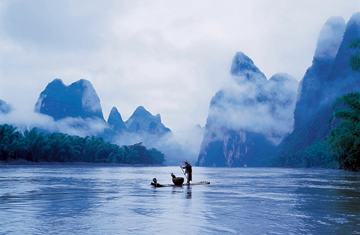
PICTURE-PERFECT: The countryside is beautiful, but stroll through the city for a taste of the real Guilin
The premises of the Guilin Winter Swimming Association on the west bank of the Li River might be the epitome of architectural reticence, but there's no doubting the chutzpah of its members. Inspired by their snappy motto — "Winter swimming is a strengthening activity" — they plunge into the waters like so many excited walruses, no matter that the temperature averages 48°F (9°C) between autumn and spring. "What are you waiting for?" asks Mr. Li — clad in voluminous trunks and smile — of a passing pair of inquisitive visitors. "Have a dip. Our oldest member's 93. Go on, in with you. Don't be shy."
It's tempting — of all the many attractions in this southwestern Chinese city, the river is its greatest. The view from the bank stretches out over not the mephitic, litter-strewn depths that often characterize China's urban rivers, but water whose clarity is as arresting as its chilliness. (See pictures of Shanghai.)
Tourist destinations in China — and Guilin's towering limestone karsts are one of the country's vacation icons — don't tend to hide their battery of lights under a bushel. Rather, their attractions are numbered and eulogized and add exponentially to their own mythology. Geology in this part of Guangxi province provided the raw material, and it was simply left to the city fathers to bathe the more obvious attractions in neon by night, to sculpt Elephant Hill slightly so it really does look like a pachyderm dipping its trunk in the river, and to add a pagoda or two to the more prominent hilltops and lakes. Millions of visitors — principally domestic groups — head to the city and its surrounds every year, dutifully tramping from one designated site to another, cruising downstream to Yangshuo past Fairy Maiden Peak, Wave Stone View and Chicken Cage Hill, filling up suitcases with osmanthus-flavored cakes and memory cards with souvenir photos.
Yet there is another side to Guilin, and one that makes the beaten-half-to-death track's must-sees seem like must-flees.
At dawn on the broad leafy sidewalk that runs along the riverfront Binjiang Lu, scores of dancers kick up their heels to pseudo-jazz tunes, moving perfectly in time and with looks of complete serenity while the instructress tends the cassette player and urges loitering spectators to join in. Further along, in front of the shutters of the Dragon Sends Travel Agency Co., Ltd., three ladies practice a version of Tai Chi combined with Ping-Pong, twirling the paddle about their bodies while keeping the ball perfectly balanced. "We come here every morning; it keeps you fit and it's fun," says the leader of the trio. "I've heard some young people join a gym," she adds, before her voice trails off in incomprehension. Guilin's residents, while welcoming the flood of tourist renminbi, seem to be happy to let the visitors tick their scheduled boxes while taking life fairly easy themselves. (See 10 things to do in Beijing.)
Just as tourists shuttle from one sight to the next, so they are funneled into Guilin's major restaurants, whose menus trumpet rice noodles — served with chicken, beef and even horsemeat — and Li River fish, though the latter is usually from a farm. But simpler fare, at much more down-to-earth prices, is available in humbler environs.
Guilin's main drag is Zhongshan Lu, running from the railway station toward Solitary Beauty Peak and Folding Brocade Hill — both featuring prominently on tourist itineraries led by flag-waving, fact-quacking guides. But Zhongshan itself is carpeted with an enticing parade of hawkers: barbecued-meat vendors alternate with bootblacks banging their brushes together to attract custom, grizzled farmers hunch over mounds of dried persimmons, and pickled-vegetable sellers rub shoulders with eco-entrepreneurs whose handwritten signboards tout for secondhand MP3 players.
Osmanthus blossoms coated in syrup and speared on a stick vie with international fast-food outlets that make gestures in the direction of local cuisine in the form of custard tarts with diced sweet potato. While the city may be best known for its rice noodles, it also does a mean line in soup, with various hole-in-the-wall cafés serving little else but broth containing double-boiled chicken and deer antler, pigeon with cicada shells and ginseng, and the like. Typical of the breed is Anyway — a pun on ai ni wei, meaning "love your tummy." Guilin's residents, despite the relentless influx of tourists, seem to have no hesitation in doing just that, and loving life into the bargain.
